LEICA M7
LEICA M7
LEICA M7
Create successful ePaper yourself
Turn your PDF publications into a flip-book with our unique Google optimized e-Paper software.
The <strong>LEICA</strong> <strong>M7</strong> Absolute reliability in all situations, emergency<br />
operation without batteries, the use of the very best materials, great<br />
value retention, longevity, high-precision optical and mechanical<br />
components : typical characteristics of the new <strong>LEICA</strong> <strong>M7</strong>, the fast<br />
and convenient alternative to the <strong>LEICA</strong> M6.<br />
The range-viewfinder system is an optical masterpiece, created<br />
for photographic work at the highest level. Unlike a reflex system, in<br />
which the focal length and the light intensity affect the measurement,<br />
the measuring base of the rangefinder in the Leica M always remains<br />
the same, regardless of the lens that is being used. That is why its<br />
accuracy with short focal length lenses is many times more accurate.<br />
In addition, a special method of distance measuring guarantees fast,<br />
accurate and razor-sharp focusing, even under extremely poor light<br />
conditions. In order to enhance contrast and brightness even further,<br />
an especially scratch-resistant multi-coating is now being applied to<br />
the viewfinder windows. All the other information that is relevant for<br />
a perfect result, as well as the surroundings of the subject is visible<br />
in the bright-line viewfinder – ideal prerequisites for spontaneous,<br />
inconspicuous photography. There are three viewfinder magnifications<br />
to choose from : The wide-angle and eyeglass wearer version of 0.58 x,<br />
the universal magnification of 0.72 x and the tele variant of 0.85 x.<br />
Exposure metering Backlighting, sports illumination or laterally grazing light results<br />
in different colors, brightnesses and contrasts. A challenge that the <strong>M7</strong> meets without<br />
difficulties. Its selective through-the-lens exposure metering is activated by a slight<br />
pressure on the shutter release button. A photo diode then measures the light that<br />
is reflected from a white spot on the shutter curtain and gathered by a collector lens.<br />
This selective exposure metering works absolutely precisely and thanks to its high<br />
sensitivity, it can even be used in candlelight. In conjunction with the stepless automatic<br />
shutter speed control, perfectly exposed images are possible under all conditions<br />
without any problems.<br />
The mechanisms are unsurpassed in terms of precision and dependability. Highgrade<br />
materials are used exclusively : The top plate of the <strong>M7</strong> is milled from a solid<br />
block of brass by a modern process. The main body and the housing are made of<br />
lightweight but extremely rugged die-cast aluminum. The <strong>LEICA</strong> <strong>M7</strong> works quickly,<br />
easily and above all, quietly – it has no noisy hinged mirrors and spring-loaded<br />
automatic diaphragms. Therefore the sound of the shutter release is significantly<br />
more quiet than the familiar clatter of single-lens-reflex cameras. The chromeplated<br />
rapid-change bayonet and the few knobs and switches are equally robust<br />
and long-lived. They are positioned so conveniently and designed so ergonomically<br />
that they can even be operated while wearing gloves. With their palpable marking,<br />
Leica lenses can also be changed in the dark. They can be placed on a surface<br />
without their protective back covers because there are no protruding pins and<br />
levers that could be damaged.<br />
The automatic shutter speed control Faster, more convenient and reliable : In addition<br />
to the familiar manual exposure settings, the <strong>LEICA</strong> <strong>M7</strong> features a stepless automatic<br />
shutter speed control – once the f-stop has been selected on the lens, the camera’s<br />
electronics automatically determine the ideal shutter speed for the correct exposure,<br />
even for long exposure times of up to 30 seconds. Another innovation : With the exposure<br />
value storage at the release button, the desired exposure can be retained for<br />
a particular part of the subject. And when desired, the exposure override feature now<br />
also permits over- or under-exposures of ± 2 exposure values of entire exposure<br />
sequences.<br />
The viewfinder displays 33 display items within an area of just 0.7 x 2.3 mm constitute<br />
a masterful achievement that is unique in a rangefinder camera. Especially because the<br />
readings are displayed at 15 x magnification, so that the photographer has an optimal<br />
overview of all the information he needs for a good exposure at a single glance. The<br />
automatically generated shutter speed is indicated by an LED display at the bottom<br />
of the large and bright viewfinder image. The proven light balance was preserved for<br />
using the <strong>LEICA</strong> <strong>M7</strong> in the manual mode. For long exposure times, the viewfinder display<br />
shows the time that remains. In the “B” time exposure mode, the display counts the<br />
elapsed seconds upwards. The brightness of the display adjusts itself automatically<br />
to the prevailing subject brightness, assuring the best visibility even in bright sunlight,<br />
and in available light situations it prevents the display from blinding the observer.<br />
The shutter The unique cloth focal plane shutter of the Leica M is legendary.<br />
While retaining all its advantages, it has now been completely redesigned in<br />
order to incorporate the electronic control of the exposure times, which is<br />
the foundation of the equally new automatic shutter speed control. Two<br />
mechanically controlled shutter speeds of 1/60 second and 1/125 second<br />
guarantee the functionality of the <strong>LEICA</strong> <strong>M7</strong> even when the batteries are<br />
dead. Furthermore, the shutter release cycle that was already extremely<br />
quiet, fast and vibration-free in the preceding M6 model, has been retained.<br />
The exposure delay amounts to a mere 25 milliseconds in spite of the electronic<br />
control and thus it is nearly ten times faster than that of a conventional<br />
autofocus single-lens-reflex camera.


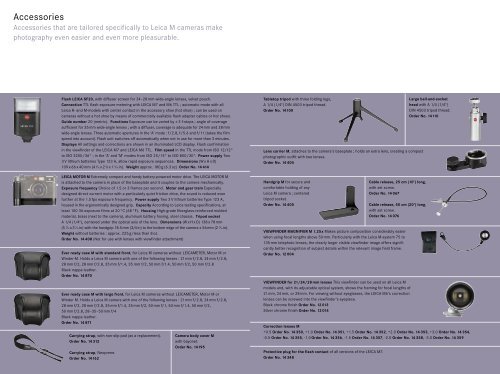

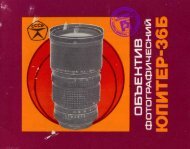

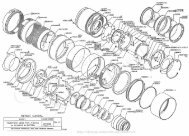



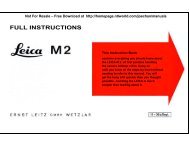
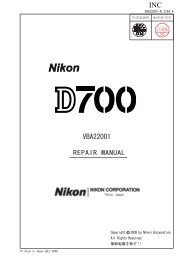
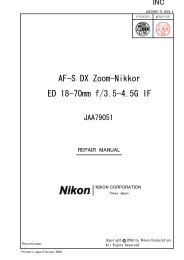
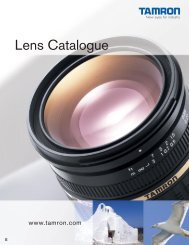

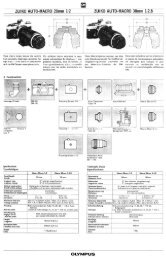

![AF 200 - 400 mm F/5.6 LD [IF] (Model 175D) - Tamron](https://img.yumpu.com/18616610/1/190x245/af-200-400-mm-f-56-ld-if-model-175d-tamron.jpg?quality=85)